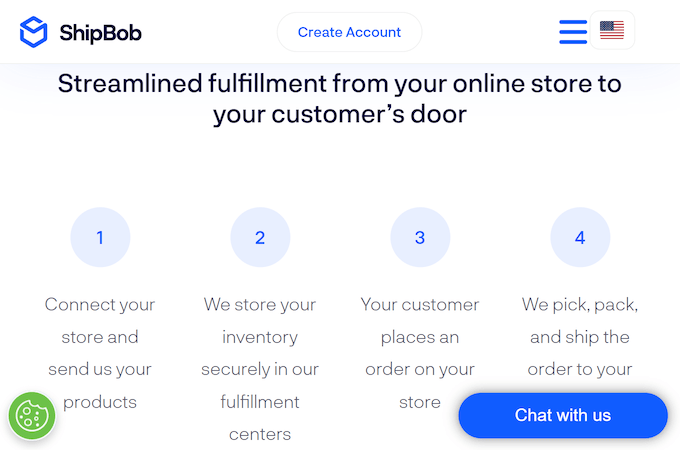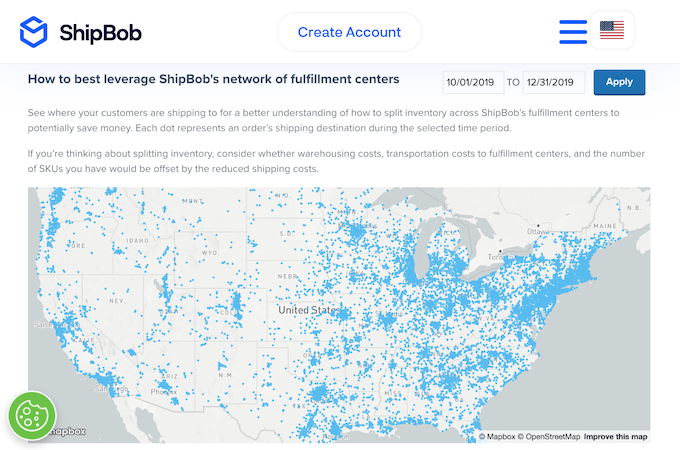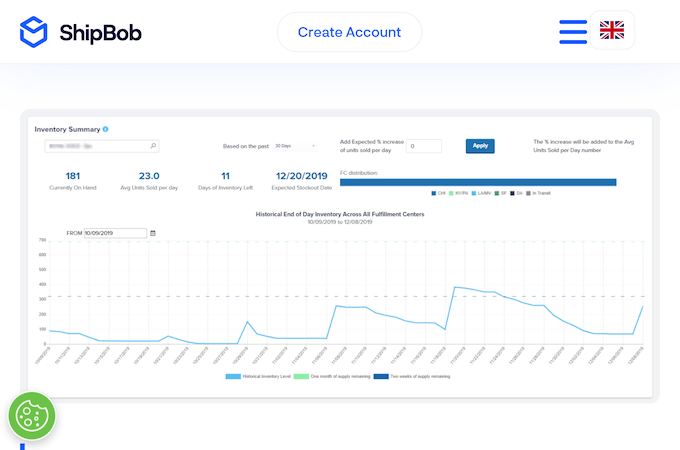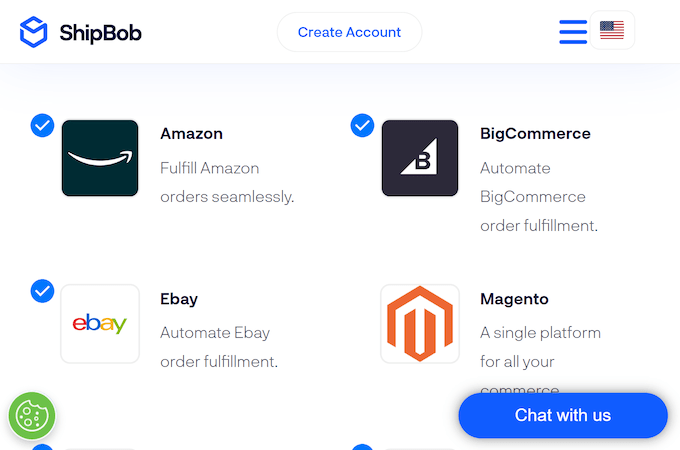If you want to outsource ecommerce fulfillment, ShipBob is the best service for most. Get a free quote from ShipBob today.
Optimizing fulfillment is essential to the growth of your online store. You must ensure the process is efficient and cost-effective on your end while keeping your customers happy by delivering their orders in a timely, convenient fashion. Here we’ll explain everything you need to know about the ecommerce fulfillment process and teach you how to do it most effectively.
The 5 Best Ecommerce Fulfillment Services
We reviewed the top ecommerce fulfillment services on the market today and appraised them on key differentiating factors such as scalability, shipping times, and supply chain expertise. Here are our top choices from that list:
- ShipBob – Best ecommerce fulfillment platform
- Red Stag Fulfillment – Best for high-value and large products
- ShipMonk – Best for subscription boxes
- Dot Foods – Best for food and beverage ecommerce
- Easyship – Best for international fulfillment
What Is Ecommerce Fulfillment?
You’ve had to consider ecommerce fulfillment from the moment you started your online business. It’s the crux of your business model, especially if you don’t have any brick-and-mortar stores for your customers to visit.
Ecommerce fulfillment refers to the storage, sorting, packing, and shipping of the products you sell on your online store, as well as the management of returns and exchanges. Some ecommerce companies take care of this entirely in-house, while others employ third-party fulfillment solutions.
If you have an actual inventory of products that need to be physically shipped to the people who order them from you, this contrasts with a couple of other ecommerce models. Some companies only deal with digital products, ranging from SaaS companies to online content creators, eliminating the need to consider shipping and fulfillment at all.
On the other hand, dropshipping companies don’t sell their own inventory; instead, they use vendors and providers to source inventory (who store the stock themselves and ship directly to the dropshipping store’s customers). Dropshippers still have to consider aspects of fulfillment, like picking-and-packing and shipping providers, but don’t have to fret about storage.
For most ecommerce stores, an efficient ecommerce fulfillment process is vital. Customers expect quick and reliable delivery, and a positive delivery experience means customers are more likely to return to your store and have a greater lifetime value.
How Ecommerce Fulfillment Works
Ecommerce fulfillment can be broken down into four steps: inventory management, order processing, shipping, and returns management.
Inventory management is just like it sounds. It requires that your product inventory be stored securely in a warehouse or similar facility. Each product needs a unique stock-keeping unit (SKU) number to keep track of it along the supply chain.
When you outsource the inventory management part of your fulfillment, that entails you sending inventory to the fulfillment company’s own warehouse. You’ll pay more for that convenience but can often unlock benefits like shorter time spans between the receipt of an order and when it ships out. And, if your fulfillment partner has multiple warehouses, you can often get items to your customers more quickly by having inventory in a warehouse nearest to their shipping address.

Order processing describes the sequence of events from when you get a customer’s order to prepare it for shipment. Your staff receives the information about the customer’s order, where to find the products in your inventory, shipping information, and any specific packing instructions. At the fulfillment center, staff retrieve the items, pack them, and add a shipping label.
Then, the package is shipped using the U.S. Postal Service or another carrier, like UPS, DHL, or FedEx. Whether you do this yourself or use a fulfillment service, you’ll receive tracking information that you can pass on to the customer and use to send delivery updates via email or text.
Returns management doesn’t always come into play, but it’s a crucial part of this process to prepare for. To facilitate and receive returns from customers, you must provide the means for them to send defective or mistakenly ordered products back to your company. For example, you might set up a page on your website that describes your return policy and a returns portal customers can use to print off shipping labels.
When you receive returns, they must be assessed and their value recovered where possible through resale. Alternatively, you’ll need to dispose of faulty items or items that no longer meet compliance regulations efficiently.
The Different Types of Ecommerce Fulfillment
Here are the three main ecommerce fulfillment models to consider.
In-house fulfillment entails storing and shipping products from your own premises. This may suit small or new ecommerce stores, as well as direct-to-consumer businesses that handle every step of the customer journey themselves.
Third-party fulfillment is when you send your inventory to a service provider that stores, picks, packs, and ships your products. This is the right option for growing businesses or those that want to scale effectively. A third-party provider has the infrastructure and technology to speed up shipping and reduce costs.
Dropshipping is a uniquely modern ecommerce model. You outsource manufacturing as well as fulfillment to a third party, essentially acting as a middle person promoting goods and getting a cut of the profits. This suits online entrepreneurs with little to no starting budget. Yet, it’s also difficult to make a ton of money from dropshipping alone.
Which Is the Best Ecommerce Fulfillment Model?
You may start small, even bootstrap an ecommerce store handling shipping from your own home or a small office. But, as your business grows, the logistics get more complex, not to mention more expensive.
In general, you should invest in a third-party fulfillment solution as soon as you feel financially able to do so. It means you can expand your product line, sell to more customers, and speed up the entire supply chain process, providing a better ROI and a better customer experience overall.
Third-party services like ShipBob have multiple distribution centers, meaning you can store and ship inventory from different locations across the country, close to where your customers live. It reduces the cost of shipping and means your packages arrive much quicker—a real win-win.

It’s crucial that you offer fast, reasonably priced delivery to stay in business. 68% of consumers abandon their shopping carts when shipping costs are too high, and 44% abandon their purchases when the estimated delivery time is too long for their liking.
Furthermore, third-party services automate much of the fulfillment process. For instance, inventory levels are automatically updated, and you’ll receive analytics reports containing sales insights and notifications to replenish inventory.

In other words, you get to focus on other aspects of your growing business and leave the complex processes to the robust tools that third-party fulfillment services have to offer.
The 5 Best Ways to Improve Ecommerce Fulfillment
Streamline processes, reduce costs, and increase shipping speeds to improve the ecommerce fulfillment process. Here are the most effective ways to do these things.
1. Offer Faster Shipping
Big companies have the infrastructure to ship products to customers super fast. ASOS, for example, is able to offer same-day delivery in the UK.
Customers have come to expect fast delivery times. The trouble is, it’s expensive for your average ecommerce store to make this happen.
But there are ways to get around this problem. Third-party fulfillment solutions have the infrastructure to be able to guarantee two-day delivery, for example.
They optimize where your products are shipped from and how they’re shipped. ShipBob’s two-day express fulfillment service uses a combination of ground, air, and regional carriers to transport goods, for example.
To lessen the cost of shipping, you can also use certain pricing strategies. Add shipping costs to the overall cost of the product to cover the expense of free or cheap delivery. Or, set up a minimum spend threshold on free delivery.
2. Use a Multichannel Fulfillment Program
Multichannel sales grow year on year in the United States. Selling on marketplaces, social media, and other channels in addition to your website is the norm these days.
This is because modern consumers require a simple, convenient shopping experience. They want to be able to buy items using their preferred channel or whatever app they’re browsing at the time.
This means your ecommerce fulfillment system must be equipped to handle multiple channels. Choose software or a third-party service that integrates with top sales channels as well as your online store. It makes the entire process more manageable.
ShipBob, for one, integrates with major channels such as Amazon, eBay, and Walmart.

Orders get sent to the fulfillment center from each channel automatically—you don’t need to be the middle person. This is another way you can streamline the fulfillment process.
3. Choose Optimal Storage Locations
Ship items from close to where your customers live to optimize shipping costs and speeds.
Shipping is calculated using zones based on the distance between the package’s point of origin and its destination. So, the closer the origin zone is to the destination zone, the better.
The best option is to store and ship from multiple locations. You can optimize the process in a granular way, using analytics data to store the right inventory in the right locations based on consumers’ purchase behaviors. ShipBob uses an algorithm to do this, for example. Or, you can manually determine what the best fulfillment provider is based on how close their warehouses are to your core customer base.
4. Adopt End-to-End Supply Chain Visibility
Capture and analyze data across your entire supply chain to increase efficiency. End-to-end visibility like this means you can improve processes, reduce costs, and make better business decisions.
It also ensures information about your inventory, orders, and shipping is accurate at every step of the ecommerce fulfillment process. Data and information are centralized, so everyone involved has the same, up-to-date information.
Technology is a game changer here. Industry experts say the aspects of the fulfillment operation ecommerce companies want to advance most in the next year are mechanization, automation, and robotics.
You can use a platform focused on supply chain analysis to increase visibility. Another option is to use technology such as devices equipped with GPS to accurately track the whereabouts of products and shipments while en route. Also, automating processes at each stage of the fulfillment process helps you track inventory accurately.
5. Reduce the Number of Returns
Returns are a natural part of running an ecommerce business, but they cost a lot of money. In 2021, returns accounted for $218 billion in lost sales for ecommerce stores around the world.
Assessing the quality of your supply chain can help you reduce the number of returns your customers make.
First, robust inventory management is key. For instance, the information on packing slips must be accurate to ensure the customer receives the right items. Automation reduces the possibility of human error here.
Naturally, products must also be stored in a safe and secure environment to reduce the likelihood of damage. And don’t cut costs when it comes to packaging. You’ll lose more money if an item is damaged in transit due to insufficient packaging.
Also, make sure to only work with credible shipping services. Naturally, customers are more likely to return an item if it’s damaged in transit or they don’t receive it on time.
5 Ecommerce Fulfillment Trends to Look Out For
It pays to stay on the cutting edge in the world of ecommerce fulfillment and supply chain management. Gain a competitive advantage by taking note of these trends:
Eco-conscious consumers: Customers care more about the environmental impact of their shopping habits. This means ecommerce companies should invest more in eco-friendly packaging and make sustainable values a part of their branding.
Predictive logistics: Using behavioral data, companies can predict what shoppers will buy and when. This means brands can have their inventory ready in the right warehouse at the right time, making fulfillment even faster and more efficient.
Real-time tracking: Companies can track their inventory and keep tabs on any order’s status in real-time by using a robust warehouse management system. This allows the brand to adjust any shipping details right up until it’s due to leave the fulfillment center.
Return to retail: Customers are increasingly shopping in-store as they crave authentic, in-person experiences that virtual stores have trouble replicating. Shipping delays, costs, and other missteps from brands are also driving people back to stores. For this reason, companies should place a greater emphasis on retail fulfillment—alongside ecommerce—than they may have previously.
Collect-in-store: Similar to the previous point, this is a smart fulfillment strategy that benefits both brands and consumers. By shipping to brick-and-mortar stores in bulk, companies are able to reduce shipping times and costs, leading to greater profits for the brand and better customer satisfaction. However, keep in mind that this won’t always be feasible for customers who may live in more remote areas.
Final Thoughts About Ecommerce Fulfillment
Ecommerce fulfillment is an important competitive differentiator nowadays. Fast, cheap, stress-free delivery is high on the list of customer expectations. Businesses must make that happen while keeping costs low.
Using a third-party ecommerce fulfillment solution is the best choice. They have the infrastructure, systems, and software to keep processes manageable, streamlined, and cost-effective. And they adapt to the ever-changing ecommerce environment well.
Automation, optimal locations, and end-to-end visibility are key to improving your ecommerce fulfillment process. This is also true of staying on top of logistics, supply chain, and fulfillment trends to ensure your company’s fulfillment strategy remains effective which contributes to the success of your online store.
